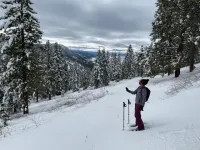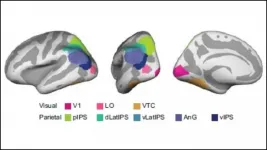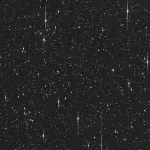Traditional hydrologic models may misidentify snow as rain, new citizen science data shows
Tahoe Rain or Snow weather spotters help reduce inaccuracies in estimating precipitation in the Sierra Nevada
2021-02-22
(Press-News.org) Reno, Nev. (Feb. 22, 2021)- Normally, we think of the freezing point of water as 32°F - but in the world of weather forecasting and hydrologic prediction, that isn't always the case. In the Lake Tahoe region of the Sierra Nevada, the shift from snow to rain during winter storms may actually occur at temperatures closer to 39.5°F, according to new research from the Desert Research Institute (DRI), Lynker Technologies, and citizen scientists from the Tahoe Rain or Snow project
The new paper, which published this month in Frontiers in Earth Science, used data collected by 200 volunteer weather spotters to identify the temperature cutoff between rain and snow in winter storms that occurred during the 2020 season. Their results have implications for the accuracy of water resources management, weather forecasting, and more.
"Scientists use a temperature threshold to determine where and when a storm will transition from rain to snow, but if that threshold is off, it can affect our predictions of flooding, snow accumulation, and even avalanche formation," said Keith Jennings, Ph.D., Water Resources Scientist at Lynker Technologies and one of the lead authors on the study.
Previous studies have found that thresholds used are particularly problematic in the Sierra Nevada, where a significant proportion of winter precipitation falls near 32°F. When the temperature is near freezing, weather forecasts and hydrologic models have difficulty correctly predicting whether it will be raining or snowing.
Tahoe Rain or Snow was launched in 2019 to take on the challenge of enhancing the prediction of snow accumulation and rainfall that may lead to flooding by making real-time observations of winter weather. The team is comprised of two scientists, one education specialist, and about 200 volunteer weather spotters from the Lake Tahoe and western slope regions of the Sierra Nevada and Truckee Meadows.
"Tahoe Rain or Snow harnesses the power of hundreds of local volunteers. The real-time observations that they share with scientists add an incredible amount of value to the study of hydrology and clarify crucial gaps left by weather models," said Meghan Collins, MS, Education Program Manager for DRI and another lead author on the paper.
In 2020, these citizen scientists submitted over 1,000 timestamped, geotagged observations of precipitation phase through the Citizen Science Tahoe mobile phone app. Ground-based observations submitted by the Tahoe Rain or Snow team in 2020 showed that a much warmer temperature threshold of 39.5°F for splitting precipitation into rain and snow may be more accurate for our mountain region. In contrast, a 32°F rain-snow temperature threshold would have vastly overpredicted rainfall, leading to pronounced underestimates of snow accumulation. Such model errors can lead to issues in water resources management, travel planning, and avalanche risk prediction.
"Tahoe Rain or Snow citizen scientists across our region open a door to improve our understanding of winter storms", said Monica Arienzo, Ph.D., Assistant Research Professor of Hydrology at DRI and another lead author on the paper. "Growing our team of volunteer scientists is important given that climate change is causing the proportion of precipitation falling as snow to decrease, and they help enhance the predictions of precipitation that we rely on in the Sierra Nevada and Truckee Meadows."
Tahoe Rain or Snow is continuing in 2021. To join, text WINTER to 877-909-0798. You will find out how to download the Citizen Science Tahoe app and receive alerts as to good times to send weather observations. Tahoe Rain or Snow particularly needs observations from sparsely populated, remote, or backcountry areas of the Sierra Nevada.
INFORMATION:
More information:
For more information on the Tahoe Rain or Snow project, please visit: https://www.dri.edu/project/tahoe-rain-or-snow/
[Attachments] See images for this press release:

ELSE PRESS RELEASES FROM THIS DATE:
2021-02-22
Long before COVID-19 entered the picture, West Virginia had been battling two other major public health crises: opioids and HIV.
Dr. Sally Hodder, a leading infectious disease expert at West Virginia University, believes that despite the threat of COVID-19, the opioid and HIV epidemics should not be ignored. The two have become so intertwined in the Mountain State, that they must be treated together, she said.
"We cannot try to solve the opioid epidemic or our emerging HIV epidemic by combating them separately," said Hodder, who serves as director of the West Virginia Clinical and Translational Science Institute and associate vice president ...
2021-02-22
In order to remember similar events, the brain exaggerates the difference between them. This results in divergent brain activity patterns but better memory performance, according to new research published in JNeurosci.
Memory is subjective. Different people recall the same event in unique ways, and people exaggerate the difference between similar events in their own life. Yet this type of bias can be advantageous when it helps the brain distinguish between similar things and prevent confusion.
In a study by Zhao et al., participants memorized different sets of faces paired with colored objects. Some ...
2021-02-22
The cover for issue 46 of Oncotarget features Figure 6, "Establishment of a SARS-CoV-2 pseudovirus that expresses SPIKE protein variants on the envelope of a lentiviral core, infection of human airway epithelial cells or lung cancer cells, and demonstration of MEKi attenuation of infectivity on primary human cells," published in "MEK inhibitors reduce cellular expression of ACE2, pERK, pRb while stimulating NK-mediated cytotoxicity and attenuating inflammatory cytokines relevant to SARS-CoV-2 infection" by Zhou, et al. which reported that Natural Killer cells and innate-immune TRAIL ...
2021-02-22
Walk along the beach after a winter storm and you'll see a shore littered with wracks of giant kelp, some 30 to 40 feet long -- evidence of the storm's impact on coastal kelp forests.
Less apparent to the casual beachgoer is what happens to the submarine forests after the storm's fury dies down. This is precisely the topic of a new study led by Raine Detmer(link is external), a graduate student at UC Santa Barbara. She developed a mathematical model describing the effects of severe storms on kelp forest ecosystems, particularly the seafloor, or benthic, communities. The research, published in Ecology (link is external), reveals an ecosystem whose variability is key to its diversity.
Giant kelp ...
2021-02-22
Graphs -- data structures that show the relationship among objects -- are highly versatile. It's easy to imagine a graph depicting a social media network's web of connections. But graphs are also used in programs as diverse as content recommendation (what to watch next on Netflix?) and navigation (what's the quickest route to the beach?). As Ajay Brahmakshatriya summarizes: "graphs are basically everywhere."
Brahmakshatriya has developed software to more efficiently run graph applications on a wider range of computer hardware. The software extends GraphIt, a state-of-the-art graph programming language, to ...
2021-02-22
Understanding how the immune system responds to acute brain hemorrhage could open doors to identifying treatments for this devastating disease. However, up until now, there has been limited information on inflammation in the brain from human patients, especially during the first days after a hemorrhagic stroke.
This led a team of researchers to partner with a large clinical trial of minimally-invasive surgery to tackle defining the human neuroinflammatory response in living patients.
"Our goal was to find out, for the first time, how certain key cells of the immune system are activated when they enter the brain after a hemorrhage and how this may shift over the first week. This ...
2021-02-22
For only the second time, astronomers have linked an elusive particle called a high-energy neutrino to an object outside our galaxy. Using ground- and space-based facilities, including NASA's Neil Gehrels Swift Observatory, they traced the neutrino to a black hole tearing apart a star, a rare cataclysmic occurrence called a tidal disruption event.
"Astrophysicists have long theorized that tidal disruptions could produce high-energy neutrinos, but this is the first time we've actually been able to connect them with observational evidence," said Robert Stein, a doctoral student at the German Electron-Synchrotron (DESY) research center in ...
2021-02-22
In a time of extreme political polarization, hearing that a political candidate has taken a stance inconsistent with their party might raise some questions for their constituents.
Why don't they agree with the party's position? Do we know for sure this is where they stand?
New research led by University of Nebraska-Lincoln political psychologist Ingrid Haas has shown the human brain is processing politically incongruent statements differently -- attention is perking up -- and that the candidate's conviction toward the stated position is also playing a role.
In other words, there is a stronger neurological response happening when, for example, a Republican takes a position favorable to new taxes, ...
2021-02-22
Abu Dhabi, UAE, February 22, 2021: Learning more about what motivates people to join violent ideological groups and engage in acts of cruelty against others is of great social and societal importance. New research from Assistant Professor of Psychology at NYUAD Jocelyn Bélanger explores the idea of ideological obsession as a form of addictive behavior that is central to understanding why people ultimately engage in ideological violence, and how best to help them break this addiction.
In the new study, END ...
2021-02-22
Establishing a consistent sleep schedule for a toddler can be one of the most challenging aspects of child rearing, but it also may be one of the most important.
Research findings from a team including Lauren Covington, an assistant professor in the University of Delaware School of Nursing, suggest that children with inconsistent sleep schedules have higher body mass index (BMI) percentiles. Their findings, published in the Annals of Behavioral Medicine, suggest sleep could help explain the association between household poverty and BMI.
"We've known for a while that physical activity and diet quality are very strong predictors of weight and BMI," said Covington, the lead author of the article. "I think it's really highlighting that ...
LAST 30 PRESS RELEASES:
[Press-News.org] Traditional hydrologic models may misidentify snow as rain, new citizen science data shows
Tahoe Rain or Snow weather spotters help reduce inaccuracies in estimating precipitation in the Sierra Nevada






